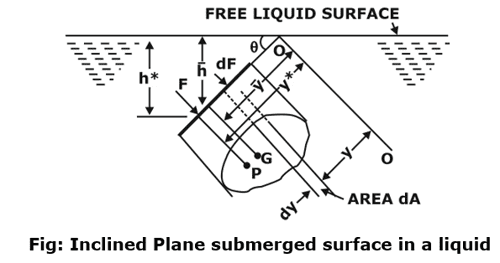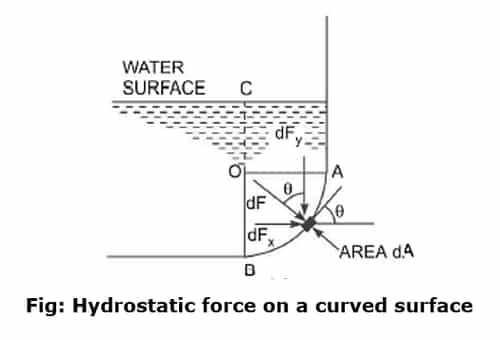Fluid Statics
- Fluid statics deals with problems associated with fluids at rest. The fluid can be either gaseous or liquid.
- Fluid statics is generally referred to as hydrostatics when the fluid is a liquid and as aerostatics when the fluid is a gas.
- The only stress we deal with in fluid statics is the normal stress, which is the pressure, and the variation of pressure is due to only the weight of the fluid. Therefore, the topic of fluid statics has significance only in gravity fields, and the force relations developed naturally involve the gravitational acceleration (g).
- The force exerted on a surface by a fluid at rest is normal to the surface at the point of contact since there are no shear forces due to the absence of relative motion between the fluid and the solid surface.
- The applications of fluid statics include the calculation of forces acting on floating or submerged bodies and the forces developed by devices like hydraulic presses and carjacks. The design of many engineering systems such as water dams and liquid storage tanks requires the determination of the forces acting on the surfaces using fluid statics.
Pressure
- The pressure is defined as external normal force per unit area and its SI unit is N/m2 or Pascal (Pa).
Units of pressure
- 1Pascal= 1N/m2
- 1MPa= 1N/mm2
- 1bar= 105 Pascal=0.1N/mm2
- 1atm=101.325 kPa=0.101325 MPa
- 1atm= 1.01325 bar = 760 mm Hg = 10.3 m of water column
Types of pressure
Atmospheric pressure (Patm)
- Atmospheric pressure is the pressure exerted by environmental air.
- Atmospheric pressure is measure by a device known as a barometer. It was invented by Torricelli.
Gauge Pressure (Pgauge)
- Gauge pressure is the pressure that is measured with respect to atmospheric pressure.
- Gauge Pressure can be positive (+ve) or Negative (-ve).
- Vacuum pressure (vacuum) or pressures less than atmospheric are known as negative (-ve) gauge pressure.
Absolute pressure (Pabs)
- These are the pressures that are measured with respect to the zero pressure line.
- Absolute pressure is always positive.
Fig: Illustration of Gauge and atmospheric pressure
Note.1:
- For all numerical problems, we have to find gauge pressure until and unless absolute pressure is asked.
- All the negative Gauge pressures are taken and considered with a negative sign.
Pascal’s Law
- It states that pressure or intensity of pressure at a point in a static fluid (fluid is in rest) is equal in all directions.
HYDROSTATIC LAW
The pressure at any point in a fluid at rest is obtained by the Hydro-static Law. It states that the rate of increase of pressure in a vertically downward direction must be equal to the specific weight of the fluid at that point.
Pressure: P = ρgZ
where P is the pressure above atmospheric pressure and Z is the height of the point from the free surface.
Here Z is called pressure head.
Note.2:
- Hydrostatic law can be applied to both compressible and incompressible fluids.
The Hydrostatic Paradox
- The pressure at any point depends only upon the depth below the free surface and the unit weight of the liquid.
- The pressure does not depend upon the size and shape of the container. Hence, the pressure at the bottom of all containers will be the same if they are filled with the same liquid up to the same height.
Hydrostatic forces
- When a fluid is in contact with a surface is exerts a normal force on the surface which is termed as the hydrostatic force.
Hydrostatic forces on inclined plane submerged surface in a liquid
Consider a plane surface of arbitrary shape immersed in a liquid in such a way that the plane of the surface makes an angle θ with the free surface of the liquid as shown in the figure.

The force is given by
![]()
Hence force is independent of the angle of inclination (θ). Thus, a force for Horizontal and vertical submerged bodies will also be given by the same expression.
Centre of Pressure (h*)
It is defined as the point where the whole of hydrostatic force is assumed to acting.

The horizontal component of force on a curved surface

The horizontal component of force on a curved surface is equal to the hydrostatic force on the vertical projection area.
The vertical component of force on a curved surface
- The vertical component of force on a curved surface is equal to the weight of the fluid contained by the curved surface up to the free surface of the liquid.
Vertical force (FY) = weight of the fluid above the curved surface up to the free surface
- It will act at the center of gravity of the volume of liquid contained in a portion extended above the curved surface up to the free surface of the liquid.
Manometers: Manometers are used for measuring pressures by balancing the fluid column of fluid against another column of fluid of known specific gravity.
- The pressure is proportional to the height of a column of fluid.
- The instrument used to carry out the complete process is termed a Manometer.
- Types of Manometers: Barometer, Piezometer and U-tube Manometer.
- Manometers use the relationship between pressure and head to measure pressure
Piezometer
- The simplest manometer is an open tube. This is attached to the top of a container with liquid at pressure. containing liquid at a pressure.
- The tube is open to the atmosphere, the pressure measured is relative to atmospheric so it measures gauge pressure.
Limitations of Piezometer -
- Can only be used for liquids.
- Pressure must above atmospheric.
- Liquid height must be convenient i.e. not be too small or too large.
U-Tube Manometer
- It consists a U-shaped bend whose one end is attached to the gauge point ‘A’ and the other end is open to the atmosphere.
- It can measure both positive and negative (suction) pressures.
- U-Tube enables the pressure of both liquids and gases to be measured.
Note.
- The manometric fluid density should be greater than of the fluid measured, ρmano. > ρ
- The two fluids should not be able to mix they must be immiscible.

Fig. U-Tube Manometer
- Pressure in a continuous static fluid is the same at any horizontal level,
The pressure at B = Pressure at C
PB = PC
- For the left-hand arm pressure at B,
PB = Pressure at A + Pressure of height of liquid being measured
PB = PA + ρgh1
- For the right-hand arm pressure at C,
- PC = Pressure at D + Pressure of height of the manometric liquid,
PC = ρmano gh2
We are measuring gauge pressure we can subtract Patmospheric giving
PB = PC
PA = ρmanogh2 – ρgh1
Differential U-Tube Manometer,
- A U-Tube manometric liquid is heavier than the liquid for which the pressure difference is to be measured and is not immiscible with it.

Fig. Differential U-tube manometer
Inverted U-Tube Manometer:
- An inverted U-tube manometer consists of an inverted U-tube containing a light liquid.
- This is used to measure the differences of low pressures between two points where better accuracy is required.

Fig. Inverted U-Tube Manometer
Micro Manometer
- Micro Manometer is the modified form of a simple manometer whose one limb is made of a larger cross-sectional area.
- It measures very small pressure differences with high precision.
Inclined Manometer
- An inclined manometer is used for the measurement of small pressures and is to measure more accurately than the vertical tube type manometer.
- Due to inclination, the distance moved by the fluid in the manometer is more.
Buoyancy
Buoyancy is also known as the buoyant force. It is the force exerted on an object that is wholly or partly immersed in a fluid.
Archimedes Principle:
- Whenever a body is immersed in fluid either partially on fully, it experiences a net vertical force which is known as buoyant force.
- This buoyant force is equal to the weight of the fluid displaced by the body, and it acts upward through the centroid of the displaced volume.
Concept of Buoyancy:
- The point of application of buoyancy force is called the center of buoyancy and it coincides with the centroid of the wholly submerged body of the homogenous composition.
- This buoyant force is equal to the weight of the fluid displaced by the body, and it acts upward through the centroid of the displaced volume.
- For floating bodies, the weight of the entire body must be equal to the buoyant force, which is the weight of the fluid whose volume is equal to the volume of the submerged portion of the floating body.
Stability conditions of completely submerged bodies under angular deflection:
The rotational stability of an immersed body depends on the relative locations of the center of gravity (G) of the body and the center of buoyancy(B).
(a). For the stable equilibrium: B should be above G.
(b). For the unstable equilibrium: B should be below G.
(c). For the neutral equilibrium: B and G coincide.

Fig. Illustration of the stability conditions of the completely submerged bodies.
Metacentric height (GM):
The metacentric height GM, which is the distance between the center of gravity (G) and the metacenter (M) which is the intersection point of the lines of action of the buoyant force through the body before and after rotation.
Stability conditions of partially submerged bodies under angular deflection:
The rotational stability of an immersed body depends on the relative locations of the Metacenter (M) of the body and the center of gravity (G).
For a floating body to be in:
(a). stable equilibrium, point M should be above point G and thus GM is positive. The larger the GM is, the more stable is the floating body.
(b). unstable equilibrium, point M should be below point G and thus GM is negative.
(c). neutral equilibrium, point M should coincide with the G, and thus GM =0.

Fig. Illustration of stability conditions of the Floating bodies
Rolling and Pitching:
The angular displacement of a boat or ship about its longitudinal axis is known as rolling while that about its transverse axis is known as pitching.

Fig. Illustration of the rolling and pitching of a hull
The time period of Oscillation of the floating body,
The time period of the oscillation is given by the following expression,

Increasing the metacentric height gives greater stability but reduces the time period of the roll so the ship will be less comfortable for the passengers.
You can avail of BYJU’S Exam Prep Online classroom program for all AE & JE Exams:
BYJU’S Exam Prep Online Classroom Program for AE & JE Exams (12+ Structured LIVE Courses)
You can avail of BYJU’S Exam Prep Test series specially designed for all AE & JE Exams:
BYJU’S Exam Prep Test Series AE & JE Get Unlimited Access to all (160+ Mock Tests)
Thanks
Team BYJU’S Exam Prep
Download BYJU’S Exam Prep APP, for the best Exam Preparation, Free Mock tests, Live Classes.





Comments
write a comment